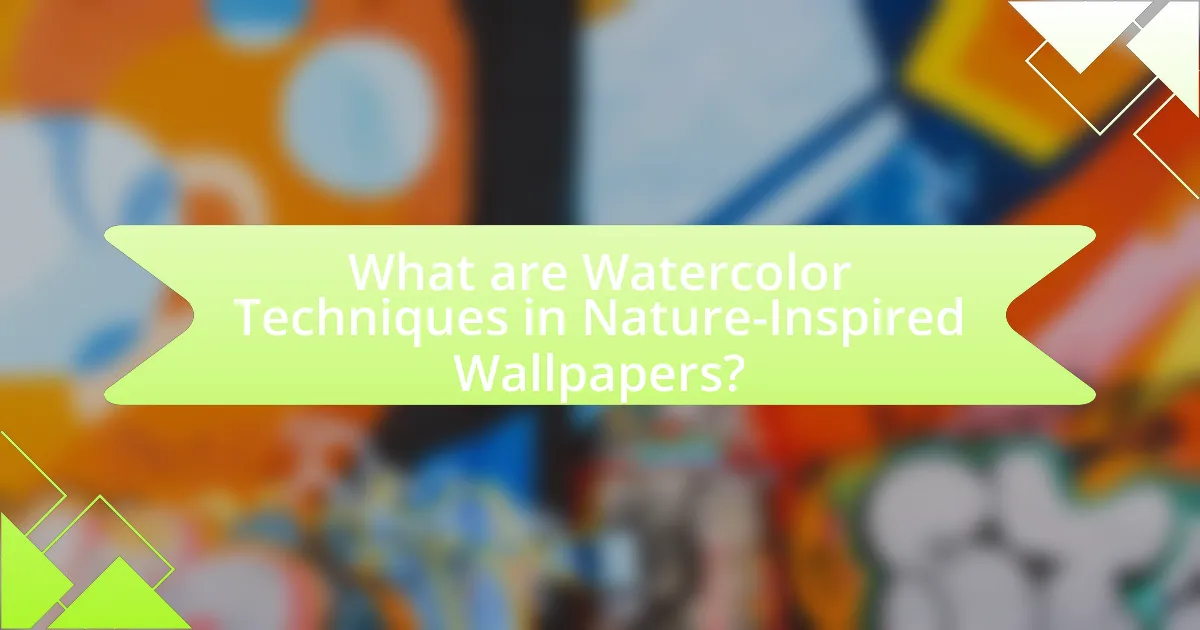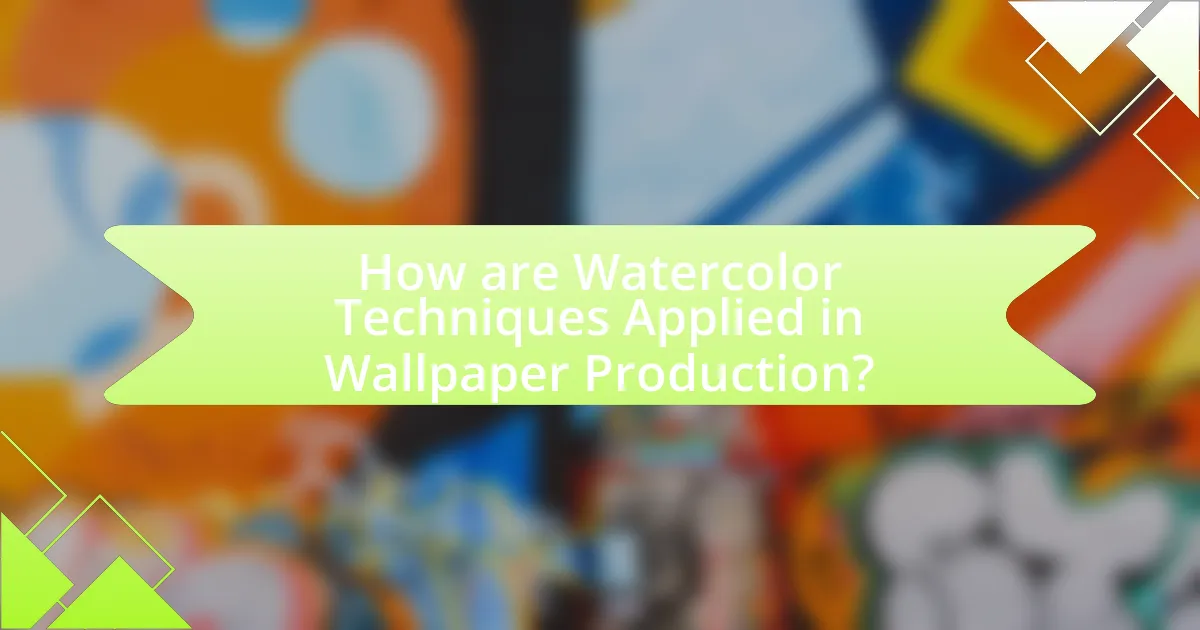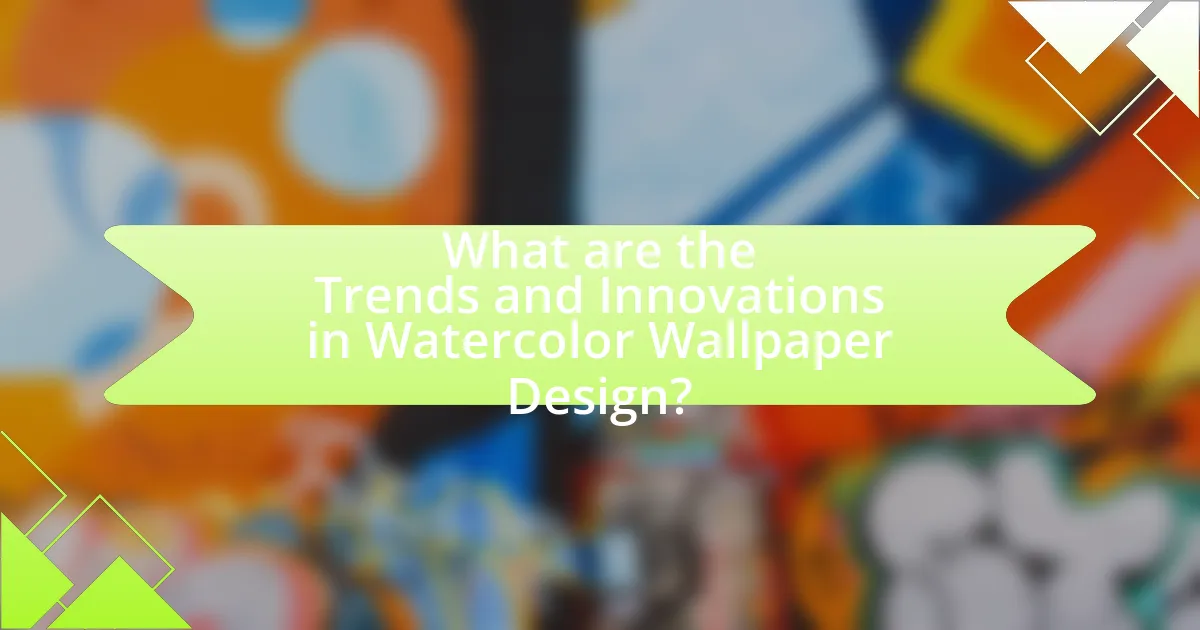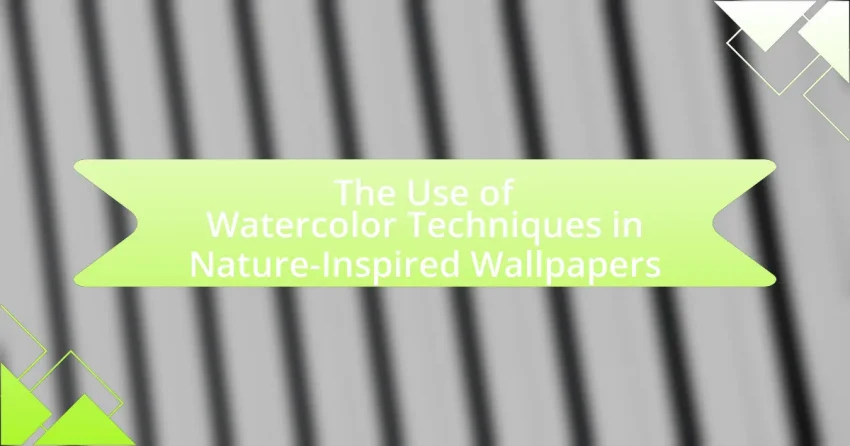The article focuses on the use of watercolor techniques in nature-inspired wallpapers, highlighting methods that replicate the fluidity and blending of watercolors to create organic designs. It discusses the unique characteristics of watercolor, such as transparency and fluidity, and explains how these techniques differ from other artistic methods. Key themes explored include floral patterns, landscapes, and the emotional responses evoked by these designs. The article also covers the production process of watercolor wallpapers, including the steps involved, materials used, and the impact of technology on design trends. Additionally, it addresses challenges in production and offers practical tips for selecting watercolor wallpapers for home decor.

What are Watercolor Techniques in Nature-Inspired Wallpapers?
Watercolor techniques in nature-inspired wallpapers involve methods that mimic the fluidity and blending of watercolors to create organic, soft designs. These techniques often include wet-on-wet application, where colors are applied to wet paper, allowing them to blend seamlessly, and dry brush techniques, which create texture by using a dry brush on dry paper. Additionally, layering colors and using gradients enhance the depth and realism of natural elements like flowers, leaves, and landscapes. The effectiveness of these techniques is supported by their ability to evoke a sense of tranquility and connection to nature, making them popular in interior design.
How do watercolor techniques differ from other artistic methods?
Watercolor techniques differ from other artistic methods primarily in their use of water as a medium to create transparent layers and fluid effects. Unlike oil or acrylic paints, which can be opaque and require different application techniques, watercolor relies on the interaction between water and pigment to achieve luminosity and subtle color blending. This unique characteristic allows for soft edges and gradients that are difficult to replicate with other mediums. Additionally, watercolor is often applied on paper, which absorbs the paint differently than canvas or wood, further influencing the final appearance of the artwork.
What are the key characteristics of watercolor techniques?
Watercolor techniques are characterized by their transparency, fluidity, and ability to create soft, blended colors. These techniques utilize water to dilute pigments, allowing for a range of effects from delicate washes to vibrant hues. The transparency of watercolor enables layers to interact, producing depth and luminosity, while the fluid nature allows for spontaneous and organic forms, making it ideal for nature-inspired designs. Historical usage in art, such as by J.M.W. Turner, showcases these characteristics, emphasizing the medium’s versatility and expressive potential in capturing natural scenes.
Why are watercolor techniques particularly suited for nature-inspired designs?
Watercolor techniques are particularly suited for nature-inspired designs because they effectively mimic the fluidity and organic qualities found in natural elements. The soft blending of colors in watercolor allows for the creation of gradients and textures that resemble the subtle variations seen in landscapes, flora, and fauna. This technique captures the essence of nature’s unpredictability, as the pigments flow and interact in ways that reflect the spontaneity of natural forms. Additionally, watercolor’s translucent layers enable artists to depict light and shadow, enhancing the realism and depth of nature-inspired imagery.
What types of nature-inspired themes are commonly used in watercolor wallpapers?
Commonly used nature-inspired themes in watercolor wallpapers include floral designs, landscapes, botanical illustrations, and animal motifs. Floral designs often feature vibrant blooms and foliage, capturing the essence of gardens and wildflowers. Landscapes typically depict serene scenes such as mountains, forests, and rivers, evoking a sense of tranquility. Botanical illustrations focus on detailed representations of plants, showcasing their unique shapes and colors. Animal motifs may include wildlife or domestic animals, adding a lively element to the wallpaper. These themes leverage the fluidity and softness of watercolor techniques to create visually appealing and immersive environments.
How do floral patterns enhance the appeal of watercolor wallpapers?
Floral patterns enhance the appeal of watercolor wallpapers by adding vibrant, organic designs that evoke a sense of nature and tranquility. These patterns create a visually stimulating environment, as the fluidity of watercolor techniques allows for soft transitions of color that mimic natural elements. Research indicates that nature-inspired designs can reduce stress and promote well-being, making floral watercolor wallpapers not only aesthetically pleasing but also beneficial for mental health. The combination of floral motifs with watercolor techniques results in a harmonious blend that transforms spaces, making them feel more inviting and alive.
What role do landscapes play in nature-inspired watercolor designs?
Landscapes serve as a foundational element in nature-inspired watercolor designs by providing a rich source of inspiration and context for the artwork. These natural scenes, characterized by their diverse colors, textures, and forms, influence the choice of hues and brush techniques used in watercolor painting. For instance, the soft gradients of a sunset or the intricate details of foliage can be translated into fluid brush strokes and layered washes, creating depth and movement in the design. The representation of landscapes in watercolor also evokes emotional responses, connecting viewers to the beauty of nature, which is essential in wallpaper design aimed at enhancing interior spaces.
Why is the use of watercolor techniques gaining popularity in wallpaper design?
The use of watercolor techniques is gaining popularity in wallpaper design due to their ability to create soft, organic patterns that evoke a sense of nature and tranquility. This technique allows for a fluid blending of colors, resulting in unique, artistic designs that can transform a space into a serene environment. The rise in demand for nature-inspired interiors has further fueled this trend, as watercolor designs often mimic natural elements like landscapes and floral motifs. Additionally, the versatility of watercolor techniques enables designers to cater to various aesthetic preferences, making them appealing to a broader audience.
How do watercolor wallpapers contribute to interior aesthetics?
Watercolor wallpapers enhance interior aesthetics by introducing fluid, organic patterns that evoke a sense of tranquility and connection to nature. These wallpapers often feature soft hues and blended colors, creating a serene atmosphere that can transform a space into a calming retreat. The artistic quality of watercolor designs adds depth and character to walls, making them focal points in a room. Studies have shown that environments with nature-inspired elements, such as watercolor patterns, can reduce stress and promote well-being, further validating their positive impact on interior aesthetics.
What emotional responses do watercolor nature-inspired wallpapers evoke?
Watercolor nature-inspired wallpapers evoke feelings of tranquility and connection to nature. These wallpapers often feature soft, flowing colors and organic shapes that can create a calming atmosphere in a space. Research indicates that exposure to nature-inspired designs can reduce stress and promote relaxation, as seen in studies highlighting the psychological benefits of biophilic design. The gentle hues and fluid forms characteristic of watercolor art can also inspire creativity and uplift mood, making them a popular choice for interior decor.

How are Watercolor Techniques Applied in Wallpaper Production?
Watercolor techniques are applied in wallpaper production by utilizing hand-painted designs that mimic the fluidity and blending of watercolor paints. This method involves artists creating original watercolor artworks, which are then scanned and digitally reproduced onto wallpaper substrates. The process captures the unique textures and color gradients characteristic of watercolor, allowing for a natural and organic aesthetic in nature-inspired wallpapers. For instance, companies like Graham & Brown have successfully integrated watercolor techniques into their collections, showcasing vibrant floral patterns that reflect the spontaneity of watercolor art.
What are the steps involved in creating watercolor wallpapers?
The steps involved in creating watercolor wallpapers include planning the design, selecting materials, painting the watercolor artwork, scanning or photographing the artwork, and finally printing the wallpaper.
Initially, the designer conceptualizes the theme and layout, ensuring it aligns with nature-inspired aesthetics. Next, high-quality watercolor paper and paints are chosen to achieve the desired texture and vibrancy. The artist then creates the watercolor painting, focusing on elements like flora and fauna to enhance the natural theme. After the artwork is completed, it is digitized through scanning or photography to create a high-resolution image. Lastly, the digital file is printed onto wallpaper material using specialized printing techniques, ensuring durability and color fidelity.
These steps are essential for producing visually appealing and high-quality watercolor wallpapers that effectively capture the essence of nature.
How is the initial watercolor artwork transformed into wallpaper designs?
The initial watercolor artwork is transformed into wallpaper designs through a digital process that involves scanning, editing, and pattern creation. First, the original watercolor painting is scanned at a high resolution to capture its details and colors accurately. Next, graphic design software is used to edit the scanned image, adjusting colors and enhancing features to ensure visual appeal. Finally, the edited artwork is arranged into repeating patterns suitable for wallpaper production, often considering scale and layout to ensure a cohesive design when printed. This method allows for the intricate textures and fluidity of watercolor to be preserved in the final wallpaper product.
What printing techniques are used to reproduce watercolor effects on wallpaper?
Digital printing techniques, particularly inkjet printing, are commonly used to reproduce watercolor effects on wallpaper. This method allows for high-resolution images that capture the subtle gradients and fluidity characteristic of watercolor art. Additionally, techniques such as screen printing and lithography can also be employed, as they enable the layering of colors to mimic the depth and texture found in traditional watercolor paintings. These printing methods are validated by their widespread use in the wallpaper industry, where they effectively replicate the organic and artistic qualities of watercolor designs.
What materials are best suited for watercolor wallpaper production?
The best materials for watercolor wallpaper production are high-quality paper, fabric, and vinyl. High-quality paper provides a suitable surface for watercolor techniques, allowing for vibrant color application and blending. Fabric, particularly cotton or linen, offers a textured finish that enhances the watercolor effect while maintaining durability. Vinyl is also a popular choice due to its water-resistant properties, making it easier to clean and maintain, which is essential for wallpapers. These materials collectively support the artistic expression of watercolor designs while ensuring longevity and practicality in wallpaper applications.
How do different paper types affect the final appearance of watercolor wallpapers?
Different paper types significantly influence the final appearance of watercolor wallpapers by affecting texture, absorbency, and color vibrancy. For instance, rough paper enhances texture and depth, allowing for more pronounced brush strokes and a tactile quality, while smooth paper results in a more uniform and polished look, which can diminish the organic feel of the watercolor. Additionally, highly absorbent papers can lead to more muted colors due to excessive ink absorption, whereas less absorbent papers maintain color vibrancy and clarity, resulting in brighter and more vivid designs. Studies in art materials indicate that the choice of paper can alter the visual impact of watercolor artworks, confirming that paper type is crucial in achieving the desired aesthetic in watercolor wallpapers.
What role does ink quality play in achieving vibrant watercolor designs?
Ink quality is crucial for achieving vibrant watercolor designs, as it directly influences color saturation, blending capabilities, and overall visual impact. High-quality inks contain finer pigments that provide richer hues and better lightfastness, ensuring that colors remain vivid over time. Additionally, premium inks facilitate smoother application and blending, which are essential for creating the soft transitions characteristic of watercolor techniques. Studies have shown that inks with higher pigment concentrations yield more intense colors, enhancing the aesthetic appeal of nature-inspired wallpapers.

What are the Trends and Innovations in Watercolor Wallpaper Design?
Trends and innovations in watercolor wallpaper design include the use of bold, vibrant colors, organic patterns, and eco-friendly materials. Designers are increasingly incorporating hand-painted effects and digital printing techniques to create unique, nature-inspired motifs that evoke a sense of tranquility and connection to the outdoors. For instance, the trend of using large-scale floral and botanical designs reflects a growing consumer preference for immersive environments. Additionally, advancements in printing technology allow for greater detail and texture, enhancing the overall aesthetic appeal of watercolor wallpapers. The shift towards sustainable practices is also notable, with many manufacturers opting for non-toxic inks and recyclable substrates, aligning with the increasing demand for environmentally responsible home decor.
How are contemporary designers incorporating watercolor techniques into modern wallpapers?
Contemporary designers are incorporating watercolor techniques into modern wallpapers by utilizing digital printing technology to replicate the fluidity and vibrancy of traditional watercolor art. This approach allows for intricate designs that mimic the organic patterns and color gradients found in nature, enhancing the aesthetic appeal of interior spaces. For instance, designers often create large-scale murals that feature botanical motifs, where the soft washes of color evoke a sense of tranquility and connection to the outdoors. The use of eco-friendly inks in digital printing further supports sustainable design practices, aligning with current trends in environmentally conscious decor.
What innovative patterns are emerging in the watercolor wallpaper market?
Innovative patterns emerging in the watercolor wallpaper market include abstract floral designs, organic textures, and gradient color blends. These patterns reflect a growing trend towards nature-inspired aesthetics, where artists utilize watercolor techniques to create soft, fluid visuals that mimic natural landscapes. For instance, the use of botanical motifs combined with watercolor effects allows for a seamless integration of indoor and outdoor environments, enhancing the overall ambiance of spaces. Additionally, advancements in digital printing technology enable more intricate designs and vibrant color palettes, making these wallpapers increasingly popular among interior designers and homeowners seeking unique decor solutions.
How is technology influencing the creation of watercolor wallpapers?
Technology is significantly influencing the creation of watercolor wallpapers by enabling advanced digital design tools and techniques. Software such as Adobe Photoshop and Procreate allows artists to replicate traditional watercolor effects digitally, providing greater flexibility and efficiency in the design process. Additionally, high-resolution printing technology ensures that these digital designs maintain the vibrant colors and intricate details characteristic of watercolor art, resulting in wallpapers that closely resemble hand-painted originals. This integration of technology not only streamlines production but also expands the creative possibilities for artists, allowing for unique patterns and textures that were previously difficult to achieve.
What are the challenges faced in the production of watercolor wallpapers?
The challenges faced in the production of watercolor wallpapers include achieving color consistency, managing drying times, and ensuring durability. Color consistency is difficult because watercolor pigments can vary in hue and saturation, leading to discrepancies in the final product. Managing drying times is crucial, as the water content can affect the application process and the overall texture of the wallpaper. Additionally, ensuring durability is a challenge since watercolor materials may not withstand wear and tear as effectively as other wallpaper types, necessitating the use of protective coatings or treatments to enhance longevity.
How do color fading and durability issues impact watercolor wallpaper designs?
Color fading and durability issues significantly impact watercolor wallpaper designs by affecting their aesthetic appeal and longevity. Watercolor wallpapers, known for their vibrant hues and delicate patterns, can lose their visual charm when colors fade due to exposure to sunlight and environmental factors. Research indicates that UV light can cause pigments to degrade, leading to noticeable discoloration over time. Additionally, durability concerns arise from the materials used; if the wallpaper is not made from high-quality, fade-resistant substrates, it may tear or wear out more quickly, compromising the overall design. For instance, wallpapers printed with water-based inks may be more susceptible to fading compared to those using UV-resistant inks. Therefore, both color fading and durability are critical considerations in the design and selection of watercolor wallpapers, influencing consumer satisfaction and the product’s market viability.
What solutions are being developed to address these challenges?
Solutions being developed to address challenges in the use of watercolor techniques in nature-inspired wallpapers include advancements in digital printing technology and eco-friendly materials. Digital printing allows for high-resolution designs that capture the nuances of watercolor art, ensuring vibrant colors and intricate details are preserved. Additionally, manufacturers are increasingly utilizing sustainable inks and substrates, reducing environmental impact while maintaining aesthetic quality. Research indicates that these innovations not only enhance visual appeal but also meet consumer demand for environmentally responsible products, as seen in the growing market for eco-friendly wallpaper options.
What practical tips can be applied when choosing watercolor wallpapers for home decor?
When choosing watercolor wallpapers for home decor, prioritize color harmony to ensure the wallpaper complements existing furnishings and decor. Selecting a color palette that aligns with the room’s overall theme enhances visual cohesion. Additionally, consider the scale of the design; larger patterns can make a bold statement in spacious areas, while smaller patterns may suit intimate spaces better. Texture is also crucial; opting for wallpapers with a tactile quality can add depth and interest to the walls. Finally, assess the lighting in the room, as natural and artificial light can significantly alter the appearance of watercolor designs, impacting their vibrancy and mood.
